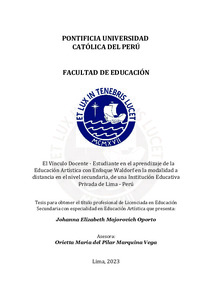El Vínculo Docente - Estudiante en el aprendizaje de la Educación Artística con Enfoque Waldorf en la modalidad a distancia en el nivel secundaria, de una Institución Educativa Privada de Lima - Perú
Abstract
En el 2020, el vínculo docente – estudiante, se enmarca en un contexto de emergencia
sanitaria por la pandemia del COVID – 19. Las clases presenciales cambian a la
modalidad a distancia. Esta investigación busca observar cómo se desenvuelve dicho
vínculo desde una dimensión emocional y cognitiva relacionada al aprendizaje de la
Educación Artística de Enfoque Waldorf, considerando que el uso de las TIC se
contrapone con la identidad Waldorf. Este trabajo tiene como objetivo general analizar
las características que presenta el vínculo docente - estudiante en la modalidad a
distancia para el aprendizaje de la Educación Artística con enfoque Waldorf de nivel
secundaria, en una IEP de Lima – Perú. Sus objetivos específicos son describir las
características que presenta la dimensión emocional de dicho vínculo e identificar las
características que presenta la dimensión cognitiva del mismo. El enfoque es
cualitativo, de nivel descriptivo y emplea un método de estudio de caso. La información
es recogida mediante entrevistas semiestructuradas aplicadas a docentes tutores y
estudiantes de secundaria de un colegio Waldorf de Lima; y por una observación no
participante aplicada a la coordinadora artística. Los resultados indican un vínculo
emocional cercano, confiable, seguro, empático y motivador. Se recomienda seguir
cuidando las características que dan identidad a este enfoque y se sugiere hacer
mejoras para estar preparados, si en un futuro el uso de esta modalidad se vuelve a
considerar. In 2020, the teacher-student bond is framed in a context of health emergency owed to
the COVID-19 pandemic. Face-to-face classes change to distance learning. This
research seeks to observe how this bond develops from an emotional and cognitive
dimension related to the learning of Artistic Education with a Waldorf Approach,
considering that the use of ICT is opposed to the Waldorf identity. The general
objective of this work is to analyze the characteristics of the teacher-student bond in
the distance modality for the learning of Artistic Education with a Waldorf approach at
the secondary level, in an IEP in Lima - Peru. Its specific objectives are to describe the
characteristics that the emotional dimension of said bond presents and to identify the
characteristics that its cognitive dimension presents as well. The approach is
qualitative, descriptive level and employs a case study method. The information is
collected through semi-structured interviews applied to tutor teachers and secondary
students at a Waldorf school in Lima; as well as a non-participant observation applied
to the art coordinator. The results indicate a close, reliable, secure, empathetic and
motivating emotional bond. And a cognitive bond that accompanies the learning
rhythms individually and in groups, giving them constant feedback. It is recommended
to continue taking care of the characteristics that give identity to this approach and it is
suggested to make improvements to be prepared, if in the future the use of this
modality is considered again.
Temas
Estudiantes y maestros--Relaciones
Método de Waldorf
Arte--Estudio y enseñanza
Educación a distancia
Educación secundaria--Investigaciones
Pandemia de COVID-19, 2020- --Educación
Método de Waldorf
Arte--Estudio y enseñanza
Educación a distancia
Educación secundaria--Investigaciones
Pandemia de COVID-19, 2020- --Educación
Para optar el título de
Licenciado en Educación con especialidad en Educación Artística
The following license files are associated with this item:






